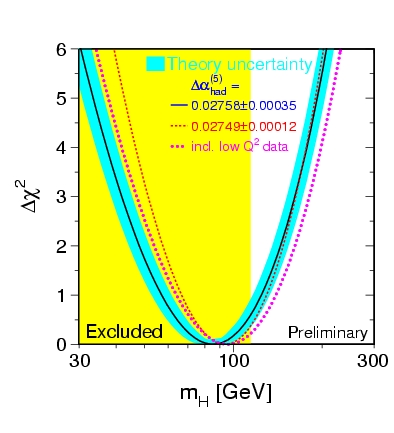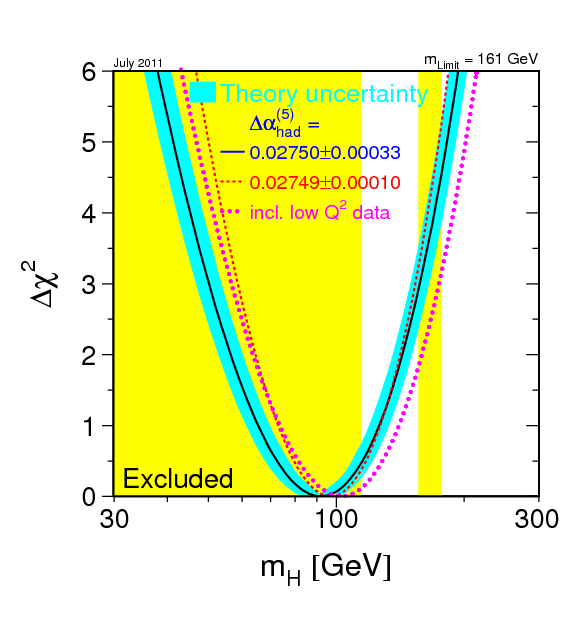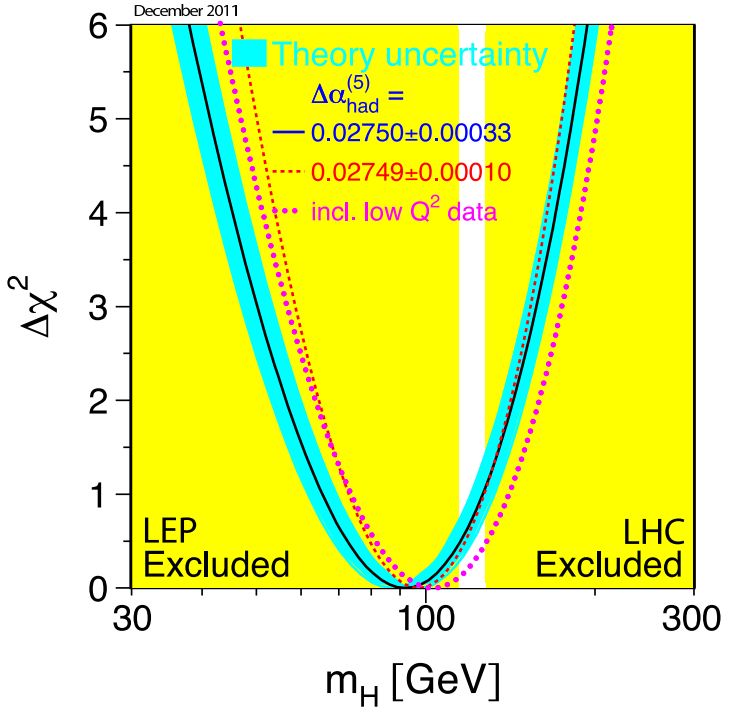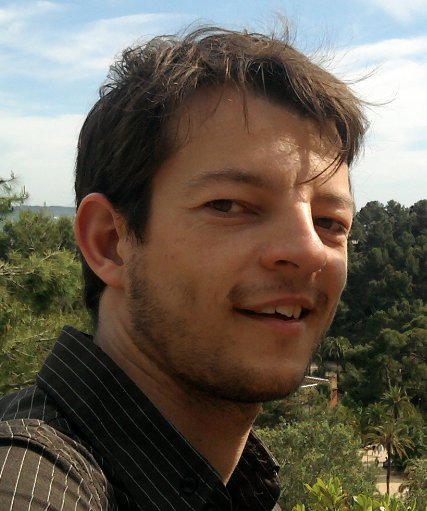What should we know about the Higgs particle?
15 August 2012 | By
1. Introduction and history
On the 4th of July, CERN announced the discovery of a new particle that can be interpreted as the Higgs boson with both the ATLAS and CMS experiments. Since this is one of the most important discoveries over the last 10 or 20 years in particle physics, let’s have a look to the full story.
First, it might be useful to look back in time. Instead of giving a list of books (there are many good ones), let me give you a few highlights quoted by Peter Higgs during one of his latest talk given in Wales on the 12th of July.

During the talk, Peter reminded us about many physicists who played a key role in the development of what has become known as the Higgs mechanism. And one would be interested to read the biographies of Yoichiro Nambu, Jeffrey Goldstone, François Englert, Robert Brout, Sheldon Glashow, Steven Weinberg, Abdus Salam, Martinus Veltman, Gerard ’t Hooft, and many others…
An important year with an amusing history was 1964, with the proposal of a new particle by R. Brout, F. Englert and Peter Higgs. On the 24th of July, the paper “Broken Symmetry Massless Particles and Gauge Fields” was accepted by the Physics Letters editor at CERN. In this paper the authors explained how to deal with the broken symmetry problem.
On July, the 31st, Peter sent his own paper “Broken Symmetries and the masses of Gauge Bosons” to the Physics Letters editor, in which he then explained how the mechanism proposed just above could (in practice) be implemented. It was rejected! During the summer, Peter reviewed his paper, adding “It is worth noting that an essential feature of the type of theory which has been described in this note is the prediction of incomplete multiplets of scalar and vector bosons”. On August 31st, the revised paper was received by Physical Review Letters, and was finally accepted! At the same time, the referee (Y. Nambu) mentioned that the same idea had just been proposed by R. Brout and F. Englert, with the paper “Broken Symmetry and the masses of Gauge Vector mesons”, which had been released exactly at the same date…
In 1975, John Ellis, Mary Gaillard and Dimitri Nanopoulos published “A phenomenological profile of the Higgs boson”. Today it could make for amusing reading: “ We apologize to experimentalists for having no idea what is the mass of the Higgs boson, …, and for not being sure of its couplings to other particles, except that they are probably all very small. For these reasons we do not want to encourage big experimental searches for the Higgs boson…”. Thankfully the scientists didn’t strictly follow these recommendations…
To close this historical part, here are some links to the original articles quoted above: the paper from R. Brout and F. Englert, the paper from P. Higgs, the paper from J. Ellis, M. Gaillard and D. Nanopoulos.
2. Motivation
During the last century, many discoveries have been made, culminating in what we call today the Standard Model.
This Standard Model has been very successful, as it could both describe and predict some experimental measurements. For instance it predicted the measurement of the anomalous magnetic dipole moment of the electron with an accuracy of around 1 part in 1 billion (a = 0.00115965218073 !). It also describes the components of matter and 3 out of the 4 interactions, but there are many remaining questions.
One of them is to understand differences in terms of mass scales. Why an electron (911 keV at rest) has such a different mass than a proton (938 MeV)… The same for other particles? Where does mass come from? etc… To answer these questions, many ideas have been proposed over the last decades, but only the Higgs mechanism remains as a serious option. One could think that the Higgs particle comes with a field, and that this Higgs field would be responsible for giving masses to particles.
3. Summary of all searches
3.1) LEP At the previous main accelerator of CERN, called the LEP, physicists started to look for the Higgs particle. The experiments ran from 1989 to 2000, and at the end, it had collected 2461 pb-1 of e-e+ collision data at centre-of-mass energies between 189 and 209 GeV. The results of the four main experiments had been merged to establish a lower bound of 114 GeV on the Higgs searches, at the 95% confidence level (C.L.).
At the end of the experiments, there was some excitement, as scientists seemed to observe an excess of 2.3 sigmas around 98 GeV, and another one of 1.7 sigma at 115 GeV. So, part of the scientific community wanted to continue to take data with LEP, and some others thought it should be better to start the next one, say the LHC... The latter won.

3.2) Tevatron Afterwards, the hunt for the Higgs continued at the Tevatron, Fermilab, in Chicago. It took proton-antiproton collisions at 1.96 TeV from 1983 to Sept. 30, 2011, and the two big experiments (CDF and D0) collected about 10 fb-1 of data, and released in June 2012 the latest update. Beyond the wonderful discoveries that the Tevatron allowed (with for instance the top quark in 1995), it gave an exclusion for a Standard Model Higgs with mass between 147 and 180 GeV, and between 100 and 103 GeV, at 95% C.L. It also saw an excess with significance of 2.5 sigmas around 120 GeV.

3.3) LHC
3.3.1) 2011 Last year, both experiments released some promising results constraining the possible allowed region of energy of the Higgs mass, using up to 4.9 fb-1 of proton-proton collision data at sqrt(s) = 7 TeV. The Higgs boson mass ranges 112.9-115.5 GeV, 131-238 GeV and 251-466 GeV were excluded at the 95% CL, while the range 124-519 GeV was expected to be excluded in the absence of a signal. An excess of events was observed around mH ~ 126 GeV with a local significance of 3.5 sigmas.

3.3.2) 2012 - 4 July 2012: Higgs discovery announced at CERN from both experiment ATLAS and CMS. - ATLAS recorded about 6.3 fb-1 at 8 TeV. Two main channels have been used: H->Gamma Gamma and H->ZZ->llll. The combined analysis revealed an excess of 5 sigmas at 126.5 GeV (4.5 sigma for H-> Gamma Gamma, and 3.4 sigmas for Higgs into 4 leptons). - CMS took about 6.3 fb-1 at 8 TeV too. It found 4.1 sigmas in H-> Gamma Gamma, 3.2 sigmas in 4 leptons, leading to a combined significance of 5 sigmas at 125 GeV. It also observed 5.1 sigmas by combining Gamma Gamma + ZZ + WW channels. Here are the two papers accepted by Physics Letters B on the 11th of August.
CMS: Observation of a new boson at a mass of 125 GeV with the CMS experiment at the LHC

4. What's next ?
Well, this is what is very exciting. This new discovery opens a large area of research. Many questions are now in the pipeline:
- Is this new particle fully compatible with the Standard Model?
- What is the nature of this particle? Is it THE Higgs boson?
- What is the spin? (zero ??)
- What are the couplings to other particles?
- What about the Higgs mechanism?
To answer some of them, we need to accumulate much more data, and it is really hard to predict how much would be enough to get the next surprise... At least it is planned to collect data with the LHC till the end of 2012. We'll see...
5. Just a last word on the Higgs decay
As we have already seen, the Higgs boson can been observed in several decay channels, such as Higgs into Gamma Gamma, Higgs into ZZ (giving 4 leptons), and also Higgs into WW. As we can see on the plot below, there are other channels we can use to detect the Higgs particle. But due to some important backgrounds (like QCD), this will require more data. After the discovery of the Higgs particle it is important to detect the Higgs decay into several decay channels to check if the coupling strength is in proportion to the mass for all fermions as the standard model predicts.





